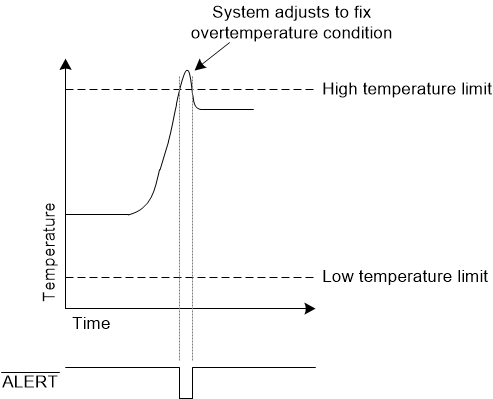SNIS227C May 2021 – June 2022 TMP126-Q1
PRODUCTION DATA
- 1 Features
- 2 Applications
- 3 Description
- 4 Revision History
- 5 Device Comparison
- 6 Pin Configuration and Functions
- 7 Specifications
-
8 Detailed Description
- 8.1 Overview
- 8.2 Functional Block Diagram
- 8.3 Feature Descriptions
- 8.4 Device Functional Modes
- 8.5 Programming
- 8.6 Register Map
- 9 Application and Implementation
- 10Power Supply Recommendations
- 11Layout
- 12Device and Documentation Support
- 13Mechanical, Packaging, and Orderable Information
Package Options
Mechanical Data (Package|Pins)
Thermal pad, mechanical data (Package|Pins)
Orderable Information
8.3.1 Temperature Limits
The TMP126-Q1 includes a temperature limit warning that can be enabled or disabled in the configuration register. If enabled, at the end of every completed conversion the TMP126-Q1 will compare the result against the limits stored in the low limit register and the high limit register. When exceeding these limits the ALERT pin will be set. The ALERT pin behavior will change depending on which mode the device is configured to as described in the Interrupt and Comparator Mode section.
The Alert functionality can allow the system to set the desired operating thermal limits of the system with the TMP126-Q1 and allow autonomous monitoring of temperature without the need for the system to read the temperature. When a thermal limit is exceeded the system will receive a warning through the ALERT pin and can react accordingly to adjust the operating temperature back to within normal system operation.
 Figure 8-1 Temperature Limit Alert
Figure 8-1 Temperature Limit Alert